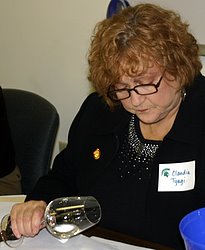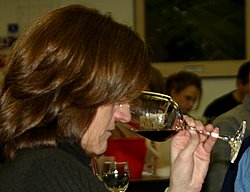Column: Arbor Vinous
“Wines change over time, just as we do,” Master Sommelier Claudia Tyagi tells the packed room. “So tasting wine is like taking a snapshot in time.”
It’s 8:30 a.m. on Groundhog Day. But instead of awaiting Punxsutawney Phil’s prognostication, more than 70 of us have fishtailed through the snow to MSU’s Extension Center near Benton Harbor for a master class in wine evaluation.
Now we’re face-to-face with banks of elegant glassware at a most atypical hour. Nearly all of southwest Michigan’s winery owners and winemakers sit at the long tables, joined a gaggle of grape growers, wine retailers and restaurateurs. Two wine geeks from Mattawan celebrate their 30th anniversary with a day off to taste wine. Along with one sleep-deprived, road-weary wine writer.
Joining Tyagi at the head table are Ann Arborite Chris Cook, Superintendent of the Michigan Wine Competition, and ex-pat sommelier Rick Ruebel, lately decamped from Detroit for the warmer clime of Charleston, South Carolina.
Over the next eight hours, we’ll glean tips on how to taste and evaluate wines. So peer over our shoulders as we prepare to take 75 snapshots of the Lake Michigan Shore wine region.
What to Taste?
The first step in tasting wine is deciding what wines you’re going to taste.

A formal place-setting for a wine tasting. The blue "spit bucket" facilitates disposal of wine remaining in the glasses after each flight, among other uses. Bread clears the palate. (Photos by the writer.)
No hard rules apply. At home with friends or neighbors, a tasting theme might be as simple as “Chardonnay pot luck” or “Bring a red wine you bought this week for $10.” Those with deep cellars (or fortuitous friendships) may plunge into such esoterica as “Vintage 1991 Cabernet Sauvignon from Napa’s Howell Mountain” or “Ten years of Chateau Beaucastel.”
With adequate notice, I’m available to attend either of the latter.
But today, we’re going to run the Lake Michigan Shore Marathon: eleven wine flights that range from three to twelve samples apiece, each featuring a single grape variety or blend.
Set the Table
The only essentials for casual wine tasting are a single glass and some wine. All else is optional.
Optional, but desirable.
Fortunately our hosts today have kitted out the tables with a more complete tasting regalia:
- Large-bowl tasting glasses that taper slightly toward the top let you first swirl the wine to aerate and release its aromas, then daintily insert your shnoz to shniff the results.
- With multiple glasses at each place, tasters can flip back and forth among wine samples, comparing their qualities and letting them rest for a few minutes to see how they change with exposure to air.
- Everyone eschews the value of placemats with numbered circles for each glass – until one of your fellow tasters wails the inevitable, “I think I may have mixed up the wines.”
- Neutral-flavored bread or crackers clear the palate between tastes. Consider them absorbent sponges for the mouth.
- Water tumblers (with bottles or pitchers for refills) serve multiple purposes: to rinse glasses, refresh your mouth and keep hydrated.
- A small, opaque cup lets you discreetly expel the remains of each taste. Optional if you’re only sampling a few wines. But as the numbers swell toward 75, a mere half-ounce swallow of each would equal a bottle and a half by the end of the day. “We don’t want our judgment to be clouded by noon,” Tyagi dryly admonishes us.
- Large buckets or pitchers distributed around the tables play the same role, somewhat less elegantly; they also facilitate disposal of wine remaining in the glasses after each flight. In polite company, these are known as “pour buckets” or “dump buckets.” My crowd calls them “spit buckets.”
Taste the Wine
Volunteers dispense small pours – two ounces or less – from the bottles into each glass.
Bottle labels lie cloaked behind wrappers, so we don’t know which wines we’re tasting. Adding to the fun: we’re told that at least one bottle in each flight is a “ringer” – a wine made elsewhere in the world from the same grape variety.
Tyagi explains that this blind tasting procedure “evens the playing field, so you don’t go into the wine with any mental preconceptions, except what you pull in from your eyes, nose and mouth. Basically, we’re playing wine sleuth.”
“So start with the visuals. Use your eyes; everything about the wine tells you something.”
Visuals include clarity, brightness, and color, which are best evaluated by looking at the wine against a white background, like a napkin or the back of your tasting sheet. White wines can range from nearly colorless to tawny, reds from opaque purple to brown.
Tyagi reminds us to swirl the wine in the glass and “look for tears, sheets or legs; these demonstrate the alcohol or sugar in the wine.”
Swirling also releases the wine’s esters and aromas. That lets us start to smell – the second part of the tasting process.
The nose is our primary sensory organ, says Tyagi; it can detect far more nuances than our sense of taste alone.
We’ll first sniff each wine for overt olfactory flaws. Perhaps there’s the wet cardboard smell of a tainted cork, or whiffs of sulfur, acetone, vinegar and funkiness, indicating contaminants or a fermentation gone awry. Do these nasties blow off after a few minutes in the glass, or have they permanently damaged the wine?
Then it’s on to more subtle considerations. Is the aroma delicate or powerful? Does it show secondary bouquet from years in the bottle, or the fresh primary fruit aromas of a recent vintage? What specific aromas do we identify – fruits, flowers, spices, herbs, earthiness? Can we detect the unmistakable toast, vanilla or butterscotch of oak?
We take a sip and swirl it around. How sweet is it – bone dry, medium or very sweet? Are the fruit flavors the same in the mouth as we picked up on the nose? Do the non-fruit flavors harmonize with the fruit, or are they at odds? If it’s a red wine, do the tannins make us feel like we’re rubbing our tongue with a piece of sandpaper?
How long does the wine’s flavor last? Tyagi reminds us that the finish is “incredibly important. The longer the wine talks to me and tells me wonderful things, that is a measure of its greatness.”
Evaluate the Wine
Finally, we’re ready for the last item on the table: the tasting sheet.
Hundred-point scoring systems dominate the consumer wine world, their simplicity to use and commercialize winning out over a lack of specificity and precision.
But today’s tasting sheet doesn’t ask anyone for a score. It focuses instead on the characteristics of each wine: sweetness, acidity, finish, complexity, flaws. That’s more useful information for the growers and winemakers in the room, since it reflects how the tasters assessed the choices they made in the vineyard and winery.
One criterion on the sheet – “Varietal Accuracy” – is tricky. Unlike dog shows, no single “breed standard” exists for grape varieties. Most can display a range of aromas, flavors and other characteristics, depending on the climate and soil where they grew and how the winemaker turned them into wine.
Michigan-grown Riesling or Cabernet Sauvignon may have bright, fresh fruit flavors, a medium body, and high acidity. The same grapes from Australia or California are likely to be softer and fuller-bodied, with lower acid and riper flavors.
What makes a wine “varietally accurate”? Probably the best answer: if its dominant aromas and flavors seem to come from the requisite grapes – as opposed to additions, manipulations, or flaws – and those flavors integrate in a balanced, harmonious manner.
Postscript: So What’s to Drink?
The panel selected a top wine for each grape variety, plus a top Meritage/Bordeaux blend.
Pinot Gris: 2008 St. Julian “St J” – 800.732.6002
Chardonnay: 2008 Hickory Creek “Zero Oak” – 269.473.2089 269.422.1100
Riesling: 2007 Hickory Creek – 269.422.1100
Pinot Noir : 2008 Karma Vista “Stone Temple Pinot” – 269.468.9463
Syrah: 2007 Domaine Berrien – 269.473.9463
Cabernet Franc: 2005 Tabor Hill – 800.283.3363
Merlot: 2007 Contessa – 269.468.5534
Cabernet Sauvignon: 2007 Domaine Berrien – 269.473.9463
Meritage: 2008 Karma Vista – 269.468.9463
Those that might find their way into the Goldberg household include the Hickory Creek Chardonnay, Domaine Berrien Syrah, Tabor Hill Cab Franc, and Karma Vista Meritage.
Because of limited production and uncertain distribution, most of these wines aren’t available from Ann Arbor area retailers, but they can be purchased and delivered directly from the wineries or their websites.
About the author: Joel Goldberg, an Ann Arbor area resident, edits the MichWine website and tweets @MichWine. His Arbor Vinous column for The Chronicle is published on the first Saturday of the month.









Thanks for the shout out to SW Michigan wineries. It’s particularly nice to see St. Julian represented. These guys were making wines here long before it was cool.
Joel
THe phone # for Hickory Creek is 1 269 422 1100, the other # is my old home phone.
Cheers
Mike
Re. #2: Mike, I made the change – thanks for alerting us.
Thanks for taking such an accurate “Snapshot” of this day, Joel – beautifully written as usual. It was an honor to participate in such a well run event. Everyone involved should take great pride in a job superbly done. I take pride in the quality & diversity of wonderful wines made in our Great Lakes area. If you haven’t tasted Michigan wines made since 2005, then you haven’t tasted Michigan wine!